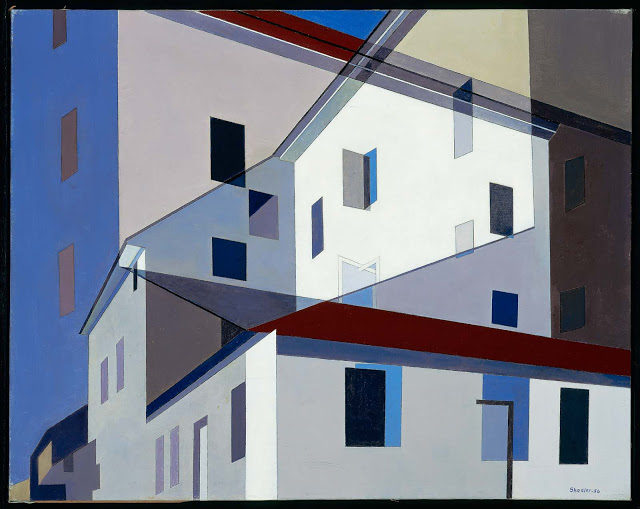The laundry and machine shop is a three and one half story building constructed in 1790. The structure served as a washhouse, machine house, herb and seed room, and woodshed and thus it exemplified the Shaker principle of maximum utility (Mary Jane Jacob, “The Impact of Shaker Design on the Work of Charles Sheeler,” unpublished M.A. thesis, 1976, quoted in Flo Morse, “The Shakers and the World’s People,” New York: Dodd, Mead & Company, 1980, p. 138). Over time and subsequent renovations it had acquired a unique shape. Two additions to the original building created interesting relationships of structural angles and forms that especially appealed to Sheeler. He depicted the building a second time in 1941 in “Shaker Detail” (The Newark Museum), showing a closer view but from the same angle as in his 1934 “Shaker Buildings.” His final two paintings of the laundry and machine shop are the Museum’s painting and “On a Shaker Theme #2” (Babcock Galleries), both composite images painted in 1956. While the first two pictures of the laundry and machine shop are straightforward representations, in the last two paintings, Sheeler interpreted the Shaker architecture in his late style, which employs more abstracted forms.
In 1946, Sheeler had begun to experiment with composite photography as a basis for his paintings. He superimposed photographic negatives, sometimes reversing them, to arrive at evocative compositions. In “On a Shaker Theme,” Sheeler overlaid two images, one slightly smaller and in reverse, of the portion of the laundry and machine shop depicted in “Shaker Detail.” He also radically simplified the details of the building so that windows and doors are reduced to rectangles. Sheeler’s method of overlapping images resulted in a complicated scaffolding of diagonals and verticals. “On a Shaker Theme” celebrates the refined geometric forms that underlie Shaker design, although its compositional intricacy eschews the Shaker virtues of purity and simplicity. This complexity, however, becomes integral to the piece if we consider the title of the painting to be musical – Sheeler had used musical titles starting in 1940 with “Fugue” [40.780] – as in Brahms’s “Variations on a Theme by Haydn.” Some of Brahms’s variations on a simple theme become quite complex with the addition of contrasting but parallel melodic lines played along with the theme. Thus Sheeler took the simple geometric shapes that he admired in Shaker architecture as his theme, and by using composite photography created an intricate tribute to a beloved building.
mfa.org, source
The American modernist Charles Sheeler (1883–1965) explored the relationships between photography, film, and more traditional media such as painting and drawing with more rigor and intellectual discipline than perhaps any other artist of his generation. As in a well-conceived scientific experiment, Sheeler used his own photographs and film stills as the basis for paintings and drawings, thus crystallizing the differences and similarities between them. Works in one medium manage to function as independent objects while also being inextricably linked to works in other media.
During Sheeler’s lifetime the essential role that photography played in his creative process was often criticized or obscured because the medium’s legitimacy as an art form remained controversial. In 1931 Sheeler himself — wary of being accused of simply copying his photographs, and at the behest of his dealer, Edith Halpert — began downplaying their connections. Yet the complex dialogue Sheeler forged among various techniques early in the century is one of his most innovative and important contributions to the history of American modernism.
Sheeler was trained at the School of Industrial Art in Philadelphia from 1900 to 1902. He then enrolled at the Pennsylvania Academy of the Fine Arts from 1903 to 1906, where he learned an impressionistic style under the tutelage of the painter William Merritt Chase. In early 1909, on a trip to Paris, he encountered the revolutionary works of Henri Matisse, Pablo Picasso, and other European modernists. Recognizing the break with the past that these artists represented, he returned to the United States determined to cast aside his previous conceptions of art and pursue a new direction in his work. Around 1910 Sheeler took up photography as a way to support his painting — first documenting buildings for local Philadelphia architects, and later photographing works of art for New York dealers. In 1913 he participated in the first comprehensive display of European and American modernism in the United States, the Armory Show in New York, where he admired the works of the iconoclastic French artist Marcel Duchamp. By 1917 Sheeler was being recognized not only for his cubist-inspired paintings and drawings but also for his innovative photographs. Alfred Stieglitz, the influential champion of modern art in America, proclaimed Sheeler, along with Morton Schamberg and Paul Strand, the “Trinity of Photography.”
***Beads strung on a chain, by themselves and beads simply added to wire or cord will not be accepted.***
Please add the tag or title MAY ABS to your photos. Include a short description, who created the art beads and a link to your blog, if you have one.
ENTRIES for ART BEAD ARTISTS!!
Monthly Challenge Recap
• From all the entries during the month, an editor will pick their favorite design to be featured every Wednesday here on ABS, so get those entries in soon.

